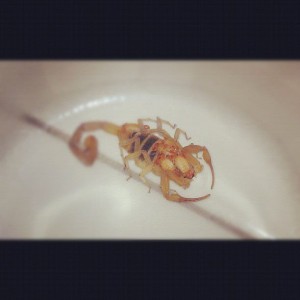Information on Tucson Scorpion Stings
Scorpions are members of the arthropod class Arachnida, which also includes spiders,daddy-long-legs, and mites.
Like other arachnids, scorpions have 2 body segments (cephalothorax and abdomen), no antennae, 4 pairs of legs, and fang-like mouthparts called “chelicerae.” Although the pincers of a scorpion resemble legs, they are “pedipalps,” which are actually mouthparts. All arachnids have pedipalps, but on most arachnids the pedipalps resemble antennae. Scorpions are equipped with a venomous stinger located on the end of the abdomen. Most scorpions have 6 to 12 tiny eyes.
No scorpion should be picked up with bare hands. Like spiders, scorpions should instead be “herded” into a container when captured. If a scorpion is found on one’s body, it should be brushed off and never swatted. If scorpions are seen frequently in a home or property, the owner should contact a pest professional to remove the infestation and identify and seal entry points into the structure.
Most scorpions are not very dangerous to people, but there are a few species in the western United States that can be deadly.
Scorpions feed on a wide range of small animals including crickets, spiders, caterpillars, and centipedes. They have very poor vision so they often lie in wait for prey, grabbing anything that wanders into their area. Development from birth to the adult stage may take more than a year. Mature individuals, up to 2-5/8 inches long, may live for another 2 years.
Crumbling rock faces, brick walls, crawl spaces, leaf-covered areas, and log piles are favorite habitats. Scorpions are most likely to be seen in or around houses from April through June but can be active until fall. Dense ground cover, such as leaf litter or mulches, tall grass, wood piles, or general clutter provide excellent protection for scorpions and the small creatures that they eat.
Encounters occur when people disturb scorpions’ “shelters”. Scorpions are not aggressive but will raise their pinchers and tail in an attempt to scare away anything that bothers them. They will strike if touched or accidentally grabbed.
Venom is produced by a pair of glands located near the end of the tail and is injected into its victim by the stinger. The sensation is a sharp pain that usually lasts for 15 to 20 minutes.
Reactions may vary depending on age or sensitivity of the individual and the amount of venom injected.
Adult reactions may include:
– Immediate pain or burning
– Swelling
– Sensitivity to touch
– A numb/tingling sensation
– Rapid breaking
Persons stung during early March or April by scorpions just emerging from their winter hiding places may have pain that lasts for several hours, plus a general numbness in the area. Scorpion stings may be red or slightly swollen. Adults should seek medical attention if they begin to experience widespread symptoms.
Reactions can be more severe, and dangerous in children. If children are stung, adults should immediately seek medical attention.
Children reactions may include:
– Intense pain or tingling but little to no swelling
– Muscle twitching or thrashing
– Unusual head, neck and eye movements
– Drooling
– Sweating
– Restlessness or excitability and sometimes inconsolable crying
Scorpions can be accidental invaders in homes and buildings where they may crawl into or under any object that affords some protection. Gaps around doors are a major entryway for them. You can prevent entry by sealing and weather stripping around thresholds and plugging gaps where utilities (wire and pipes) enter the structure. Then follow up with a major cleanup to eliminate as many potential scorpion hiding places as possible.
It is best to do this in the fall or winter, before scorpions become active in early spring.
During the summer, be careful when picking up objects. Don’t forget to look at the undersurface. Shoes and clothing should be shaken out and inspected before getting dressed. Legs on cribs or tables can be placed in wide-mouthed jars since scorpions cannot climb on clean glass. Scorpions on the body should be brushed off and never swatted.












